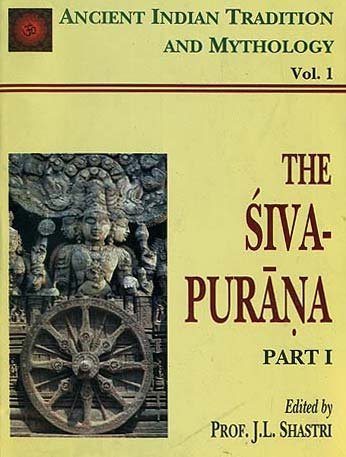The Shiva Purana
by J. L. Shastri | 1950 | 616,585 words
This page relates “greatness of the jyotirlinga kedareshvara” as found in the Shiva-purana, which, in Hinduism, represents one of the eighteen Mahapuranas. This work eulogizes Lord Shiva as the supreme deity, besides topics such as cosmology and philosophy. It is written in Sanskrit and claims to be a redaction of an original text consisting of 100,000 metrical verses.
Disclaimer: These are translations of Sanskrit texts and are not necessarily approved by everyone associated with the traditions connected to these texts. Consult the source and original scripture in case of doubt.
Chapter 19 - The greatness of the Jyotirliṅga Kedāreśvara
[Sanskrit text for this chapter is available]
Sūta said:—
1. O brahmins, the incarnations of Viṣṇu—Nara and Nārāyaṇa performed their penance in the Bhārata Khaṇḍa in the hermitage of Badarikāśrama.[1]
2. Requested by them for their worship, Śiva, being subservient to the devotees comes every day to that earthen phallic image of Śiva.
3. A long time elapsed while these two incarnations of Viṣṇu, the spiritual sons of Śiva, performed the worship of Śiva.
4. On one occasion the delighted Śiva told them—“I am delighted. Choose your boon from me.”
5. When he said this, Nara and Nārāyaṇa spoke these words keeping in mind the welfare of the world.
Nara and Nārāyaṇa said:—
6. O lord of gods, if you are delighted, if the boon is to be granted by you, O Śiva, stay here in your own form and accept the devotion of your devotees.
Sūta said:—
7. Thus requested, lord Śiva himself stayed in Kedāra on the Himavat in the form of Jyotirliṅga.
8. He was worshipped by them for helping the worlds and for appearing in the presence of the devotees. He destroys their miseries and terrors.
9. Then Śiva himself stayed there in the name of Kedāreśvara. By his sight and worship he bestows the desires of the devotees.
10. The gods and the sages of yore worship here. They get the fruit of their desire from the delighted lord Śiva.
11. Since the residents of Badarikāśrama derive their desires every day by worshipping him, he is called the bestower of the desires of his devotees ever.
12. From that day onwards, if anyone worships Kedāreśvara with devotion he will not suffer distress even in dreams.
13. It was he who on seeing Pāṇḍavas assumed the form of a buffalo, having recourse to his magical skill and began to run away.
14. When he was caught by the Pāṇḍavas he stood with his face bent down. They held his tail and implored him again and again.
15. He remained in that form in the name of Bhaktavatsala. His head portion went and remained fixed in the city of Nayapāla.[2] The lord stood in that form there.
16. He asked them to worship him in that trunkless form. Worshipped by them, Śiva remained there and granted boons.
17. The Pāṇḍavas went away with joy after worshipping him. After obtaining what they desired in their minds, they were rid of all their miseries.
18. There in the shrine of Kedāra, Śiva is directly worshipped by the Indian people.
19-20. He who makes a gift of a ring or a bracelet after going there becomes a beloved of Śiva. He comes very near the form of Śiva. He is endowed with the form of Śiva. On seeing that form of Śiva, a person gets rid of sins. By going to Badarī forest he becomes a living liberated soul.
21. On seeing the forms of Nara, Nārāyaṇa and Kedāreśvara, undoubtedly he can achieve liberation.
22. The devotees of Kedāreśa who die on the way are released from rebirth. No doubt need be entertained in this respect.
23. Going there, with pleasure, worshipping Kedāreśa and drinking the water there a person is released from re-birth.
24. O brahmins, in this Bhārata country people should worship with devotion Nara-Nārayaṇeśvara (Nara-Nārāyaṇeśvara?) and Kedāreśa.
23. Although he is the lord of the universe still he is particularly the lord of Bharata. There is no doubt that Śiva Kedāra is the bestower of all desires.
26. O excellent sages, I have narrated to you what you have asked for. On hearing this narrative the sins disappear at once. No doubt need be entertained in this regard.
Footnotes and references:
[1]:
It is the peak of the main Himalaya range in Garhwal. It has the temple of Nara-Nārāyaṇa and is a sacred place of pilgrimage. For details see ‘Geographical Encyclopedia of Ancient and Medieval India’ (Bajpai)
[2]:
See P. 1296 note.
